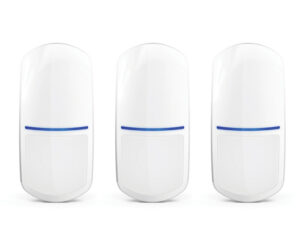 Satel produces a variety of PIR detectors within the Slimline range; the models tested and reported here are the Grade 2 “Slim-PIR-Luna” and the Grade 3 “Slim-Dual-Pro” models. The Luna version includes white-light illuminators, while this Pro version provides dual technology detection and anti-masking protection to EN 50131-2-4 if correctly configured.
Satel produces a variety of PIR detectors within the Slimline range; the models tested and reported here are the Grade 2 “Slim-PIR-Luna” and the Grade 3 “Slim-Dual-Pro” models. The Luna version includes white-light illuminators, while this Pro version provides dual technology detection and anti-masking protection to EN 50131-2-4 if correctly configured.
Getting started
The units require a 12-volt power supply that can support their maximum current consumption of 97mA with standby of 13mA for the Luna and 85mA and 21mA for the Dual Pro.
The supplied quick-start guide gives little information beyond images of good and bad mounting positions and some further basic text on installation and walk testing, so it is worth downloading the specific model’s manual from the Satel website before installing.
The casing is opened using a flat bladed screwdriver to release the ¼ turn screw in its base. To access the unit’s connections, you must first remove the circuit board. This is clipped into place and must be removed by pressing down on the two top lugs and moving the board downwards. The positioning of these lugs may give the impression that the board hinges outwards, but as stated in the manual it simply moves down (by around 6mm) and then can be lifted out. A fair amount of pressure is needed to initially release the board.
In the back of the casing there is an eleven-way connector block that carries all connections to the board and has screw terminals for external wiring. These require a small terminal driver of less than 3mm blade width and there is restricted cable space so wiring must be carefully dressed.
The first terminal is unused for the Luna model. The second (SENS) is for remote sensitivity selection, the third and fourth are tamper connections (TMP) then the fifth and sixth are the Normally Closed contact outputs (NC). The seventh and eighth are the Common and 12v DC input, ninth is for LED control, tenth for Service (SRVC) and the eleventh for Light control (LUNA).
The DUAL PRO model connections differ slightly in that the first two terminals are for Anti-Masking output (NC relay) and the eleventh is unused as there is no white light on this model.
The LED input can be switched to ground to enable / disable the Walk-Test LEDs if the internal LED link is removed. The Service input is used to remotely enter the PIRs configuration mode and the LUNA connection allows the White LED illuminators to be remotely controlled.
These PIRs are designed to be mounted at 2.4 metres height. A range of mounting hole points are provided in the case for wall or corner mounting plus a supplied adjustable bracket can be used to mount the unit onto a suitable surface for better directional positioning. The PRO version bracket includes a tamper switch that can be wired in series with the unit’s internal tamper contact.
End of Line resistors are built in and are configured using jumpers on the circuit board. The manuals show the various link options to suit the alarm system requirements.
Read the full review in the February 2020 edition of PSI magazine

